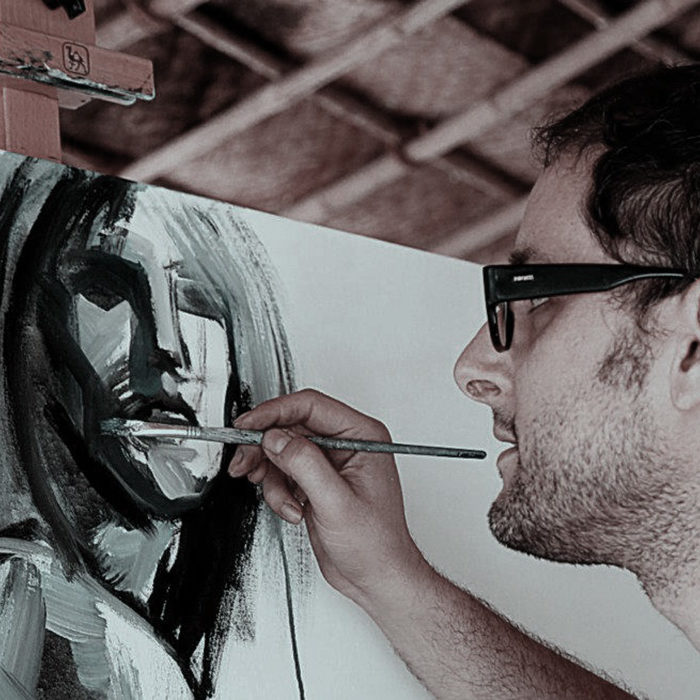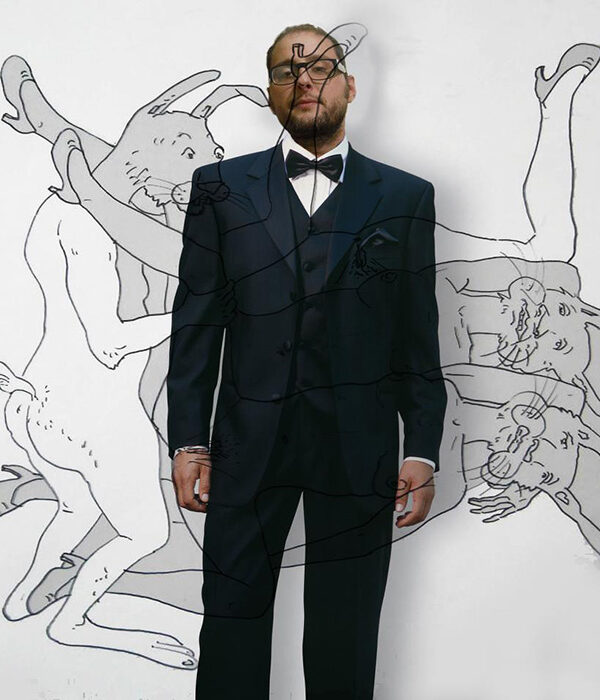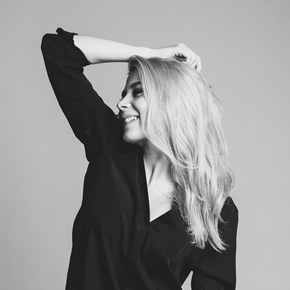
CONSTANTIN MIGLIORINI
Was born in Poggibonsi (Siena), he graduated in 1993 at the Art Institute of Siena in painting decoration and he continued his studies in Fine Arts Academy of Florence where he graduated in 1999.
He passed the third academic year in the Fine Art Academy of Siviglia thanks to the Erasmus scholarship. In 2000 thanks to the scholarship Progetto Leonardo attended an improvement course in Granada, in Spain.
Has worked on several solo and group exhibitions in Italy and abroad.
Today he teaches disciplines of painting and scenographic in the art school of Varese.
Man and his double: in the name of zoomorphic anthropology
A painting is a fabric.Literally, since it is interwoven. The warp and weft , the recto and the verso.In Constantin Migliorini’s pictures the body is intersected by the psyche,the matter is filigreed by the mind and its ghosts.
The anthropomorphic image splits in two and multiplies in a zoomorphic hall of mirrors.
The human representation is not directly overturned and complicated, as is often the case with contemporary art (e.g. Francis Bacon).
On the contrary, the conventions of visual perception are apparently maintained.
Perspective is achieved by making the tin-plated surface of the painting become a mirror which multiplies and deforms simultaneously and that opens the body surface wide onto the psychic dimension;there is no digging within the body matter,
to make a hole in it, to torture it, applying to it one of those infinite and sadistic methods of agony to which art has accustomed us to.
The soul may derive from the body lightening .The pictorial matter , the pigment, encrusts the body and makes it harden, while those lines that are as thin as threads (once again the image of a fabric) do melt it, almost dematerializing it, giving it that flimsiness which is originally of the soul, flimsy like a breath.
Earth and air, colour and line, heaviness and lightness.
I observe Constanti Migliorini’s paintings with fascination, as if it were a gallery of ancestors in a Darwinian sense, archetypal animals which we carry inside and on our backs , readable between the lines , between the folds, the wrinkles of our faces and of our backs. I observe them yet I am not disquieted by them.I know the reason why: such a pompous parade of animality does not hide the tragedy of unconscious,uncontrollable Freudian bestiality. Constantin’s art does not remind me of doctor Freud.
It reminds me of fairy tales.In his poetical imagery little devils, wolves and pigs come from the ethereal and fairy-like regions of the Orcs of our childhood.
A childhood which is more indebted to Jacob and Wilhem Grimm’s imagination than to Doctor Freud’s perverse polymorphism.
I discern something agreeably joyful here, slightly playful, because I am in the presence of ghosts’ lightness.
What is a ghost? Nothing but the ethereal projection of a matter which, in a chemical and psychoanalytical process of sublimation, turns into air.
So this is Constantin Migliorini.
I have had my own epiphany at last:he is a ghostbuster.
How many tasks an artist may carry out with painting: one may even become a ghostbuster.
Thus the zoomorphic figurines reveal fairy-like biographies, they become the diaries of those bodies that tell us of the inner child that in Plato’s opinion speaks to us all, peeping between the folds of our mouths, in our eyes’ flashes, between the wrinkles of our faces.
Prof. Ermanno Morosi


